Find this story and more in Orion’s latest anthology, Spark Birds. Order here.
I
IF I CAN BE CALLED A BIRD-WATCHER, my spark was a pair of burrowing owls, painted on the narrow storefront gate of a shuttered real estate business on 145th Street in Harlem that brokers single-room occupancy housing for two hundred dollars a week. I spotted them after ice-skating with one of my kids at the rink in the shadow of towering smokestacks at Riverbank State Park. The park is a concession to the community for the massive wastewater sewage plant hidden beneath it. It was midway through the Trump years: January, but not cold like Januaries when I was little, not cold enough to see your breath. It wasn’t snowing, and it wasn’t going to snow. The owls watched me quizzically with their heads cocked, their long skinny legs perched on the colored bands of a psychedelic rainbow that seemed to lead off that gray street into another, more magical realm.
Among people who watch birds, it’s often the case that a first bird love, the so-called “spark bird,” draws them forever down the bright and rambling path of birding. For Aimee, it was the peacocks in her grandmother’s backyard in southern India. For Kerri, it was a whooper swan above Inch Island, Donegal, the year the peace process began. For Windhorse, it was the Baltimore orioles flitting about in the high branches of poplars at his grandfather’s house up north on the lake. For Meera, it was the red-winged blackbird, there at the feeder, when she was small. Her mom told her the name and it all clicked into place—black bird, red wings—as she learned the game of language and how we match it to the world around us.
I pointed out the extraordinary owls, stopping to take a picture with the camera of my phone.
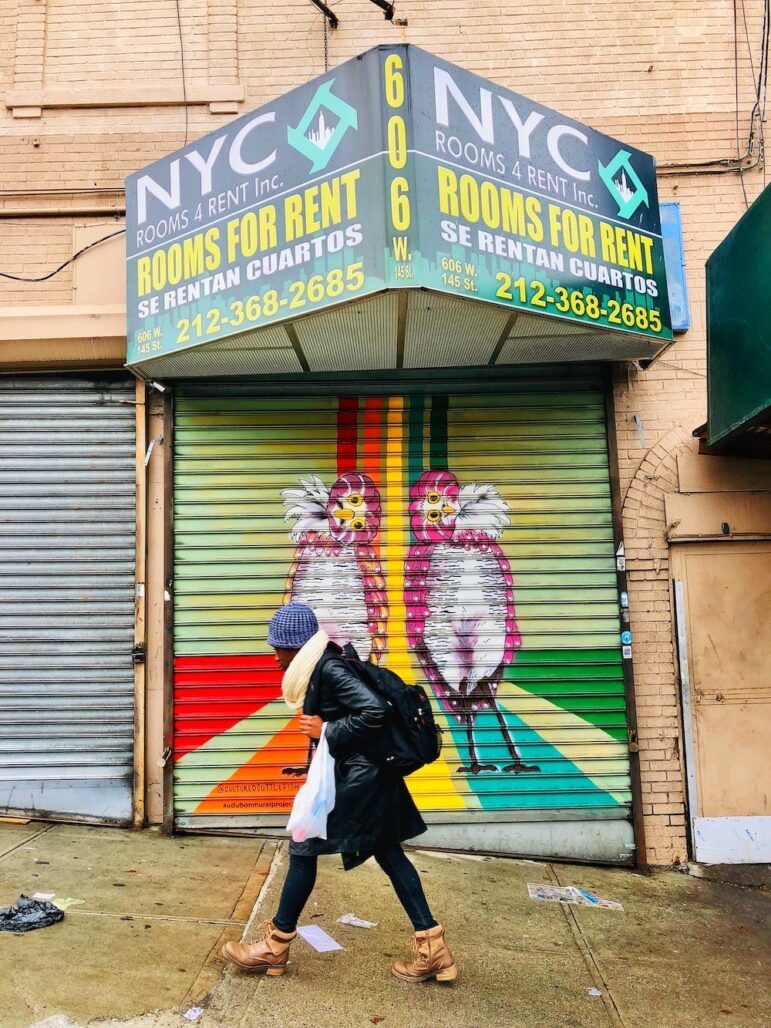
“Look,” I said.
“I want hot cocoa,” my kid replied.
We turned the corner and made our way up Broadway toward the Chipped Cup for overpriced Belgian hot chocolate. On the corner of 149th I spotted another bird, the American redstart. It was painted on the security gate of Washington Heights Pediatrics—the kind of doctors’ office that struggles to keep the lights on with trifling Medicaid payments and nebulizes asthmatic Black and brown kids, like mine, with albuterol when their lungs constrict too severely for a pump to clear at home. The tuck of color under its wing matched my kid’s unnecessary winter hat. I took another picture. Oh New York!—you gorgeous aviary of madcap design. Across the street, in the corner of my eye, were more: a pair of Calliope hummingbirds painted mid-flight outside the Apollo Pharmacy.
That’s when I understood there was a pattern.
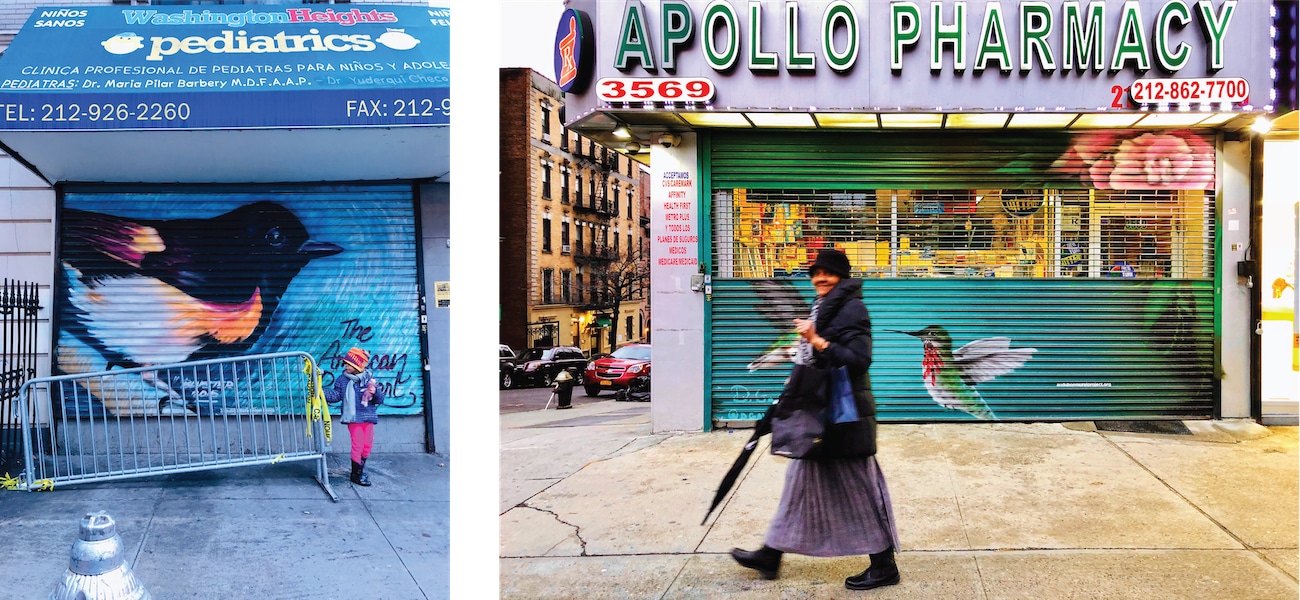
II
After the spark, I started noticing scores of them along my two-mile walk to work at City College. Most of the bird murals in Upper Manhattan are spray-painted on the rolled-down gates of mom and pop shops along the gallery of Broadway, at street level. Others are painted up higher on the sides of six-story apartment buildings. Nesting, perching, roosting in the doorways of delis, pharmacies, and barbershops. Lewis’s woodpecker at the Taqueria; the almighty boat-tailed grackle at the Buena Vista Vision Center; Brewer’s blackbird at the La Estrella dry cleaner, and so on—dozens of bird murals, each one marked in a corner with the name of the ongoing series to which they belong: the Audubon Mural Project.
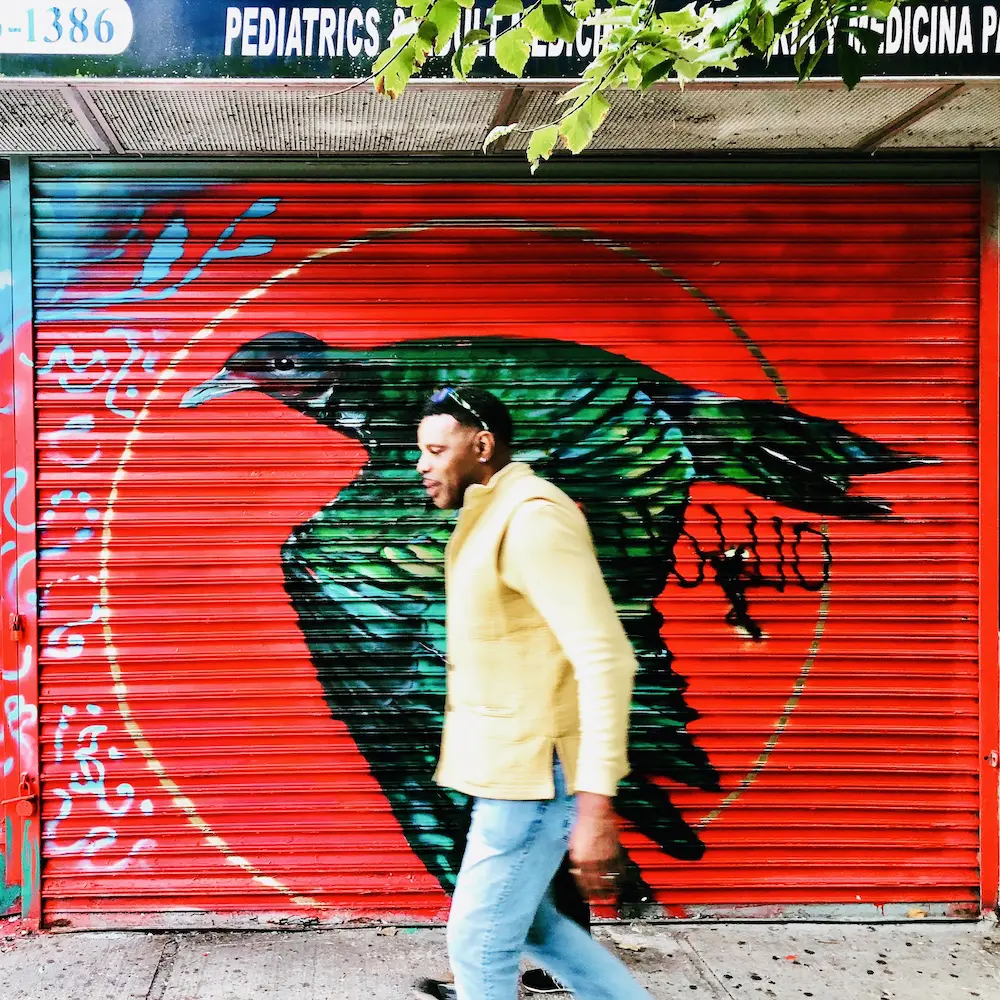
John James Audubon, the pioneering ornithologist and bird artist once lived in the hood. He’s buried in the cemetery of Trinity Church at 155th Street, midway between my apartment building in Washington Heights and my job in West Harlem, where I teach writing, sometimes using Wallace Stevens’s “Thirteen Ways of Looking at a Blackbird” as a prompt. Audubon Terrace, once part of his estate, is now the site of a complex of cultural buildings. Other uptown locales named after Audubon include a housing project, an avenue, and the ballroom where Malcolm X was killed. Its historic facade remains as cladding to a newer medical research building—a concession to Black Americans who protested the ballroom’s demolition—at 165th Street, across from the emergency room of New York-Presbyterian Hospital. When you walk by these places, as I do, you can spy many of the same birds Audubon chronicled in his masterful archetype of wildlife illustration, Birds of America (1827–1838), in the guise of public art.
The project is an unfolding environmental awareness partnership between the gallerist Avi Gitler, the National Audubon Society, and local business and property owners. The murals are sponsored through donations to Audubon and painted by myriad artists, some of them local, in a diverse range of styles. There are presently 123, and counting, bird species depicted uptown. Sometimes they disappear when businesses change hands. The project aims to reach 389. This is the number of North American species, according to Audubon’s 2019 “Survival by Degrees” birds and climate report, at risk of extinction from climate change—an alarming two-thirds of North American birds. I have attempted, so far, to photograph them all.
A printable map on the Audubon Society’s website indicates the address of each mural. I prefer not to use that resource as a guide. I like the element of surprise. As with actual birders, I never know which birds I’ll see on a walk. Sometimes a new bird appears to have landed overnight. Older birds may be marked with graffiti or sullied by weather and grime. I was saddened to discover from the window of the M4 bus while riding downtown that someone had spray-painted over the tundra swan I’d come to love with a cloudy white cipher of bubble letters. Who did that? I wondered, thinking of that rogue graffiti artist known as Spit in the 1984 hip hop movie Beat Street, who defaced the work of other artists by tagging over it.
I felt glad to have documented the tundra swan before it disappeared. If temperatures rise three degrees Celsius, 93 percent of this bird’s breeding habitat in the tundra of far northern Canada is projected to be lost. Because the Arctic is warming faster than anywhere else on the planet, tundra swans have nowhere farther north to go.

III
As a photographer I am drawn to the visual echoes between the fashion and the feathers, the postures of people and wildlife. For example, the sweep of dark a trench coat that seems to give motion to the peregrine falcon’s wings. Or the pair of black track pants that have merged with the legs of the Glossy ibis so that the young man wearing them appears to be riding the bird. I wish to document the tensions between human, bird, art, and commercial signage. Sometimes the artists play with these elements, too, as with Snoeman’s Goose Gets Down, where the bird beneath the canopy of a shoe store is styled in a pair of Timberland boots.

I understand the project has landed in this neighborhood as the site for its campaign because of its connection to Audubon, and also because of the millions of endangered birds that migrate above Manhattan and continue to nest within it. I also appreciate its potential for helping connect a low-income community of color to the green sector, which is predominantly white.
Amelia Earhart is quoted in the mural at Manuel’s grocery at 152nd Street: “No borders, just horizons. Only freedom.” The bright yellow breast of the mangrove cuckoo pictured there matches the tank of the blowtorch in the hand of the plumber passing by. That bird is described as “a rare bird native to Dominican Republic, Puerto Rico, and the U.S.” Unlike nations preoccupied with immigration, the artist states, “Birds See No Borders.”
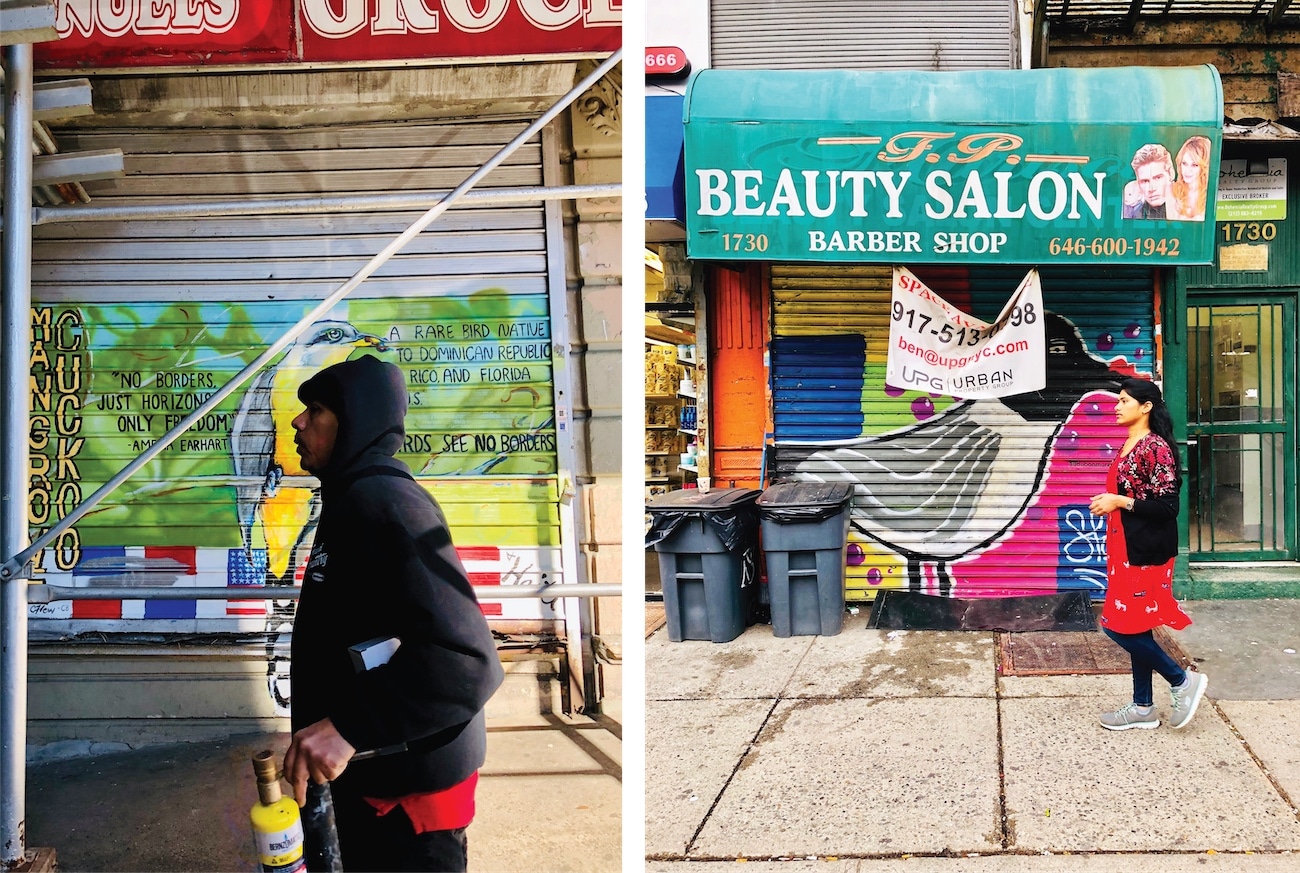
I love these birds for their beauty, the way birders love actual birds, for the exalted brushstrokes of their wingspans that lift us from the drudge of survival. Some birds are reclusive. For example, the Florida scrub jay and Mexican jay have long been trapped behind a hunter green construction fence. The birds on buildings under scaffolding look caged. At businesses that struggle to pay escalating rents by staying open for twelve hours a day, seven days a week, the birds can be seen at night only when the gates come down. At shops that have closed and not yet reopened, like the beauty salon with the laughing gull, the bird is always there.
“We know that the fate of birds and people are intertwined,” Audubon magazine’s editor in chief, Jennifer Bogo wrote me. “That’s especially true in communities, like Northern Manhattan, that suffer disproportionately from environmental and human health burdens. We hope that the Audubon Mural Project makes people literally stop in the streets and consider what’s at stake with this critically important planetary crisis, while at the same time beautifying and drawing attention to neighborhoods that have historically not been the focus of environmental protections.”
To my eye, the project is at once a meditation on impermanence, seeing, climate change, environmental justice, habitat loss, and a sly commentary on gentrification, as many of the working-class passersby are being pushed out of the hood in a migratory pattern that signals endangerment. Most of all, the murals bring me wonder and delight. I can hardly be called a bird-watcher. But because this flock has landed where I live, work, parent, pray, vote, and play, permit me to be your guide.
IV
Here’s what I can tell you about the Wilson’s warbler, which I photographed at a storefront church called Iglesia de Dios El Refugio. They typically avoid the interior of the dense forest, preferring scrubby overgrown clearings and thin woods, staying low in semi-open areas, breeding as far north as timberline, in thickets, second growth, bogs, along wooded streams, moist tangles, low shrubs, groves of willows and alders near ponds. They nest from coast to coast in Canada but are far more common in the West. In the Rockies and westward, Wilson’s warblers are often the most abundant migrants in late spring. Their young are fed by both parents but brooded by the female alone. Their diet consists mostly of insects including bees, beetles, caterpillars, aphids, and also some berries and spiders. Eight to thirteen days after hatching, young warblers leave the nest. Their nest is usually on the ground, often at the base of shrubs, sunken in sedges or moss, shaped like an open cup made of dead leaves and grass, lined with fine grass and hair. If global warming keeps apace, 61 percent of its range will be lost.
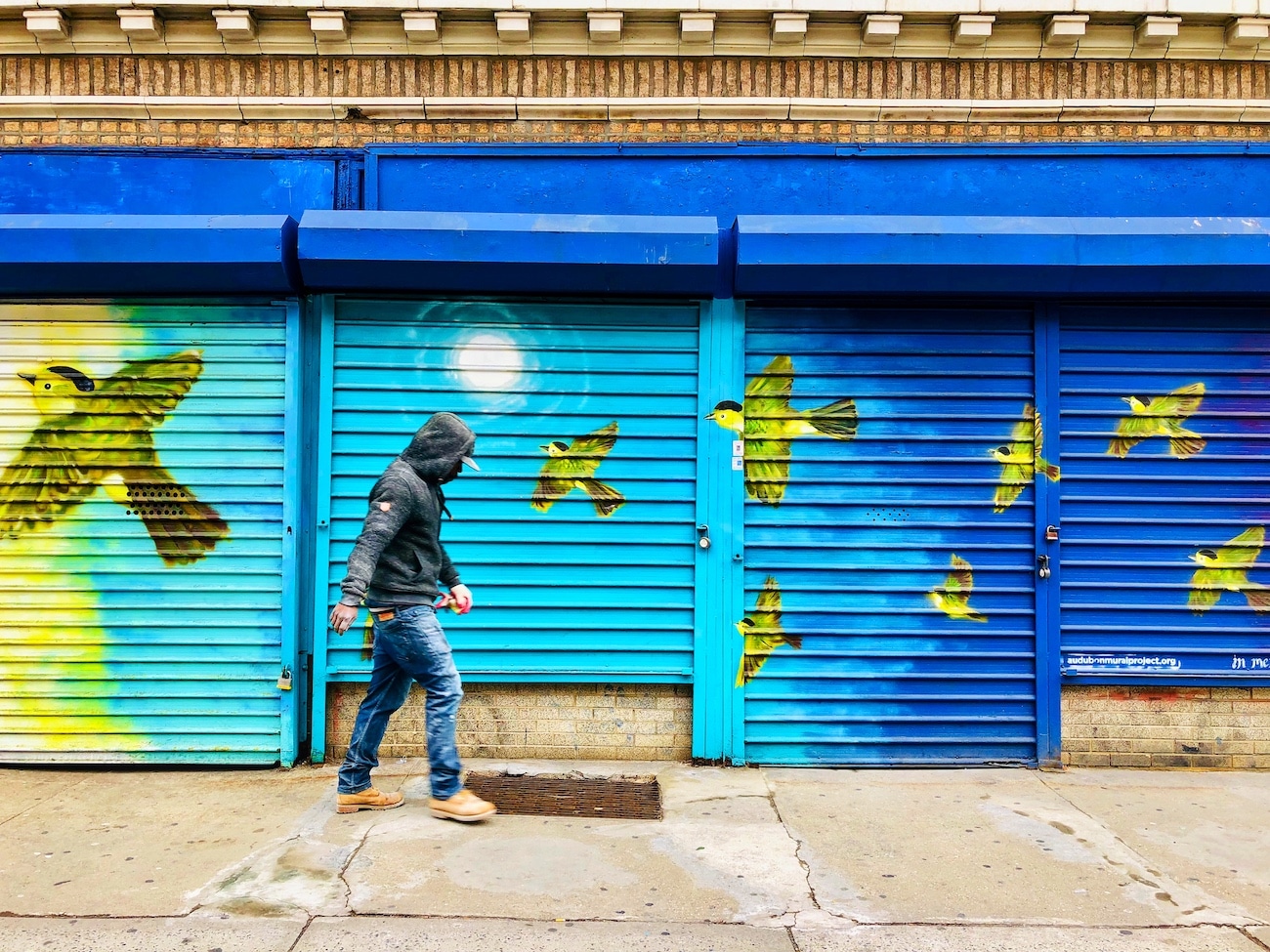
Here’s what I can tell you about my habitat in Northern Manhattan. I nest in a three-room apartment with my mate and my young on the sixth floor of a mid-rise apartment building around the corner from a commuter bus terminal run by the Port Authority and one block from the on-ramp to the George Washington Bridge, in a neighborhood choked by poverty and highways: the Trans-Manhattan Expressway, Henry Hudson Parkway, and Harlem River Drive. We talked to our young at seven and nine years old, after the murder of George Floyd, about how to protect themselves from the police, who disproportionately apprehend Black and brown youth in our habitat. Among our kind, this grim warning is known as “The Talk.” Our diet includes Chinese takeout from The Great Wall, roast chicken from Malecon, and pupusas from Mi Paso Centroamericano. On Halloween, our young eat candy they forage by trick-or-treating from the mom and pop shops along the business thoroughfare of Broadway. Across the street from the bus terminal is the church where we married, and baptized our young, and where an undocumented woman took refuge for months with her American-born children as part of the sanctuary movement, to avoid deportation to Guatemala by federal immigration agents.
Two blocks north of the Wilson’s warbler mural on Amsterdam Avenue sits an office of WE ACT for Environmental Justice, an organization that empowers low-income people of color to advocate for healthy communities. It is well documented that some of the most polluted environments in the nation are where people of color live, work, play, and pray. For instance, a 2016 environmental health report on Northern Manhattan by WE ACT stated that, as a result of risks, including poor air quality from heavy diesel truck traffic, dirty boilers, power generation plants, and polluting municipal infrastructure like bus depots and sewage treatment plants, Harlem has a childhood asthma hospitalization rate six times the national and three times the citywide average. A 2017 report from the NAACP and the Clean Air Task Force showed that Black Americans are 75 percent more likely than other Americans to live in fence-line communities sited near facilities producing hazardous waste. A 2018 study by the EPA’s National Center for Environmental Assessment found that regardless of their income level, Black Americans are exposed to higher levels of air pollution than white Americans—1.5 times as much of the pollution from burning fossil fuels as the population at large.
I am the mother of Black children in America. It’s not possible for me to consider the threats posed to birds without also considering the threats posed to us.
V
Yumi Rodriguez’s grandfather used to call her Colibri. That was his pet name for her: Hummingbird. Vuela, vuela, Colibri! he would tell her, encouraging her to fly. She was raised by her grandparents on 161st Street and Broadway across the street from the spot where she would later paint a mural in tribute to her grandfather. Like a lot of immigrants, Odalis Alvarez did a lot of things. He was a clockmaker. A blacksmith. A jewelry maker. A barber. An artist. And eventually, a business owner. He owned a chain of barbershops in the hood. Yumi describes him as her support network, a quiet person, “a wise, cool dude” with whom she watched nature documentaries.
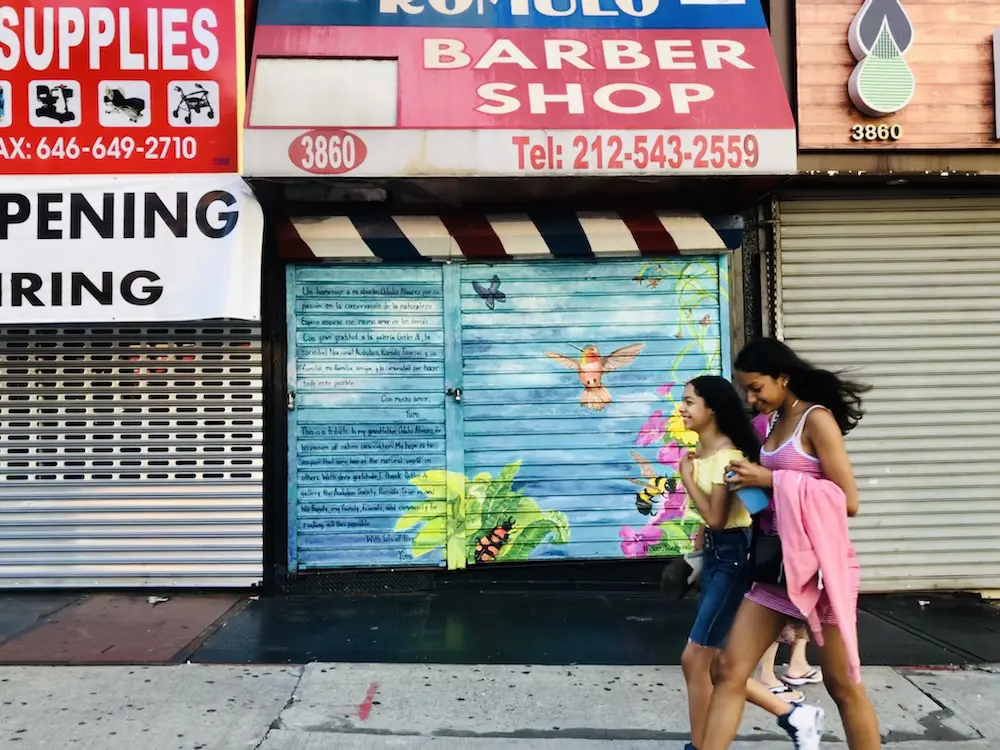
Yumi went on to get a degree in animal nursing and now works as a veterinary technician to put herself through art school at Cooper Union, where she’s pursuing public art. When Yumi’s mentor, who does anatomical illustration at the American Museum of Natural History, learned she lived in Washington Heights, he told her about the Audubon Mural Project and put her in touch with Avi Gitler. By this time, her beloved grandfather had grown ill. Yumi reached out to Avi to say she wished to paint a hummingbird—un colibri. He showed her the list of available species that hadn’t yet been represented. That’s how she chose the rufous hummingbird to paint on the gate of Romulo Barber Shop, the last place her grandfather worked. But really, she says, the bird chose her. Serendipitously, she’d read about the rufous hummingbird in a magazine that called it “the toughest bird on the block,” with a furious heartbeat and one of the longest migratory journeys for a bird its size, from Mexico to Alaska, following a route of nectar-filled seasonal blooms.
“My grandfather always said I’d persevere,” she says. “I share that characteristic with this little bird.” She took care when designing her mural that it was “not just a pretty thing,” but rather, an image for people to spectate with a sense of respect. She included insects and plants, pollinators integral to the balance of the ecosystem to keep it from collapse. She also included this text: “Un homenaje a mi abuelo, Odalis Alvarez, por su passion por la conservacion de la naturaleza.”
Yumi’s grandfather never got to see the mural. He died of prolonged heart failure in the spring of 2020, when New York City’s soundtrack was dominated by two remarkable strains of music: birdsong and sirens.
VI
During lockdown, traffic dried up on the George Washington Bridge. Without the usual car fumes, the air uptown grew impossibly clear. The din of street life died. New Yorkers with money cleared out for their second homes. It was eerily quiet, and empty. Except for the bodegas, all the storefronts closed. For the first time, I was able to spot the three warblers on the shuttered gate of Monarch Cleaners—a small consolation in the midst of chaos. Prior to the pandemic, that store was always open for business. Nobody had reason for dry cleaning now.

Nine of the ten Manhattan zip codes with the most COVID-19 cases were located uptown. The deaths were proportionate to the same demographic vulnerable to environmental racism—that is, the Black and brown poor. Let me tell you how it was. The shriek of ambulances was incessant. The medical director of a local ER committed suicide, unable to take the strain. The hospital across from the Audubon Ballroom was besieged. The dead were being forklifted into refrigerated trucks.
The murals of remembrance to the birds in my neighborhood were quickly becoming the backdrop to a grief I was yet to figure out how to grasp, much less memorialize: the lopsided COVID deaths among the Black and brown poor in environmentally hazardous zip codes such as ours. Bird-watching is a way of bearing witness—of being transported by the beauty in nature. I’m yanked from that reverie, knowing that Blackness is not a beauty that everyone sees; some see danger, and so my watching is always tenuous, provisional, unstable.
I love these birds for their beauty, the way birders love actual birds, for the exalted brushstrokes of their wingspans.
Through biological happenstance, the peak of the pandemic overlapped with the peak of the spring migration of birds along the superhighway of the Atlantic Flyway. While the city’s hospitals ran out of beds, staff, and ventilators, the birds stopped by for berries and seeds to fatten themselves on their northward journey. We could hear them clearly in that uncanny pause, filling the air with song. The plaintive call of the white-throated sparrow: “Sam Peabody . . . Peabody . . . Peabody.” The red-winged blackbird: “Cock-a-r-e-e-e.” The ospreys’ high-pitched “Killy, killy, killy.” The chirruping phrase of the scarlet tanager, “Chick-burr.” And the soft sad coo of the mourning dove.
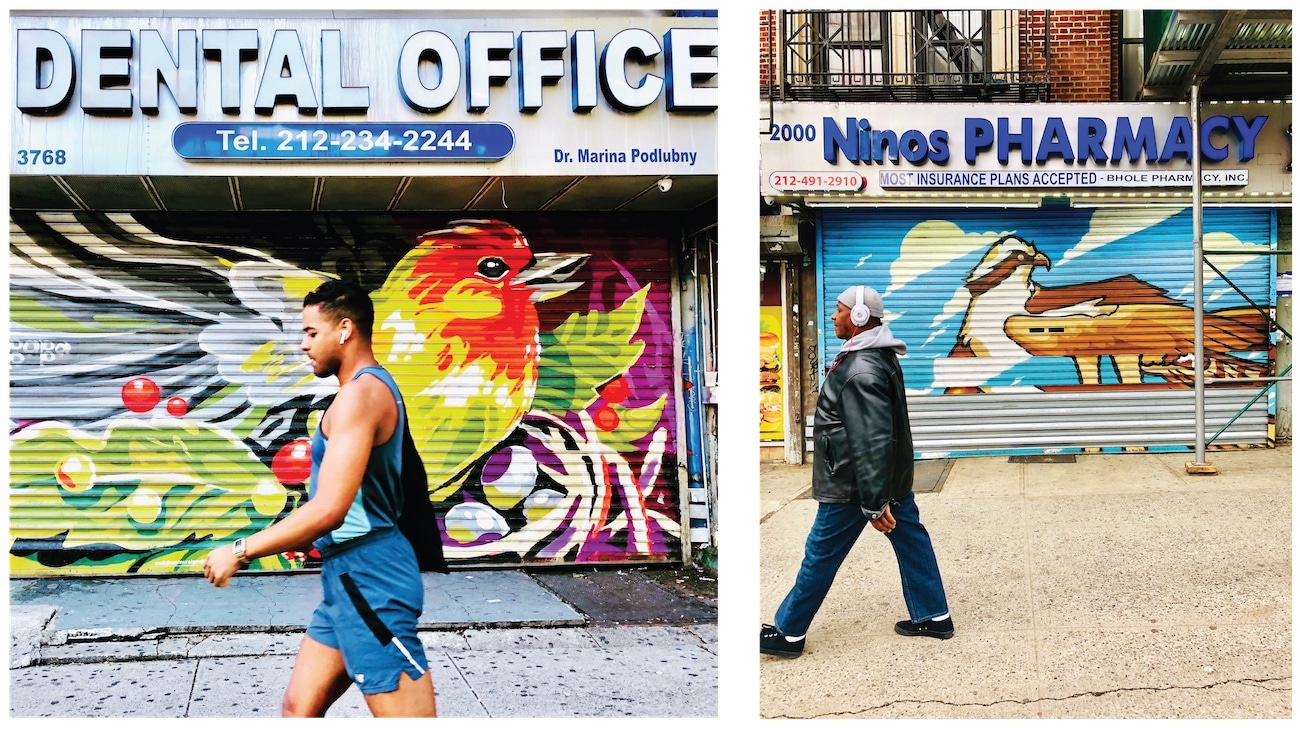
Into this spectacle of avian sound, New York City Audubon Society board member Christian Cooper stepped out with a pair of binoculars at Central Park’s Ramble on the morning of May 25—Memorial Day. A morning looking at birds in what is supposed to be a protected wild could quickly become a dangerous encounter where one’s serenity is revoked by prejudice. “I’m calling the cops. I’m gonna tell them there’s an African American man threatening my life,” Amy Cooper (no relation) threatened after he asked her to leash her dog, as per park rules. The New York City Audubon, on whose board Chris Cooper serves, has as its aim to protect birds and the places they need, today and tomorrow. But who will protect those who are watched with suspicion? Who will conserve those of us who need conserving?
That same day, in Minneapolis, George Floyd was killed by police. The video went viral on Twitter: Officer Derek Chauvin pressing his knee on George Floyd’s neck for more than eight excruciating minutes, even as he repeated, “I can’t breathe,” while horrified onlookers begged for mercy. These two news stories intertwined in the zeitgeist of a pandemic already revealing gross inequities in public health. As Black Lives Matter protests erupted across the nation, institutions that had not previously addressed racial justice as crucial to their missions responded with official public antiracism statements, nature conservation organizations among them. Audubon’s statement on the incident in Central Park begins, “Black Americans often face terrible daily dangers in outdoor spaces, where they are subjected to unwarranted suspicion, confrontation, and violence. The outdoors—and the joy of birds—should be safe and welcoming for all people.”
My God, the peculiar American insanity of this statement of the obvious. How outrageous that it needs saying at all.
PROTECT BLACK PEOPLE. COVID-19 somebody spray-painted on a mailbox near our building. At times it feels our desecration is wholesale. I could describe what it sounds like when my children can’t breathe. Or the scene, after a police raid, when my son asked me to stop walking the city, out of fear I may be shot. But Black pain is not so cheap. And Black joy is not so rare. I would rather you know that the day I took the M4 bus and wondered who had tagged the tundra swan, I was on my way to pick up free seedling kits for my children from the Horticultural Society of New York, so that we could grow pea shoots in the living room window of our apartment, through which we enjoy watching pigeons and the occasional red-tailed hawk. I would rather imagine the bird Chris Cooper was after that day in the Ramble. Maybe the black-throated green warbler, high in the overstory, calling “Zoo-zoo-zee-zoo”!?
VII
The birds became integral to my orientation in the city. I couldn’t tell you the exact cross street of the Municipal Credit Union ATM location where I and other city workers withdraw cash, but I could tell you it’s right next to the American bald eagle.

One pre-pandemic night after a book party at Alianza Dominicana on 166th Street, I took two friends on an impromptu guided walking tour down Broadway to show them the birds. Kamila lit a joint. By the time we reached the oversize mural of the swallow-tailed kite and other birds at the gas station on the corner of 155th, she was high. I expected her and Aisha to be as enchanted with the birds as I was, but the more of them we encountered, the more edgy Kamila became. She said she felt like she was in Hitchcock’s The Birds, being watched, under attack. The number of birds was alarming to her. She felt increasingly surrounded.
The weed could have been making her paranoid, warping her perception. But as we approached the pinyon jay over Manny’s Restaurant and Lounge near 151st, Aisha, who had never seen the birds and was perfectly sober, said she agreed with Kamila—there was something sinister about them. The murals seemed to her like flags planted by an outside entity, laying claim to the neighborhood.
Aisha’s uneasy feeling had to do with real estate. Habitat loss. She suspected the birds had landed to invite or delight an incoming class of people with more money than the people who’d lived here for a long time. Hipsters. White folks. The kind of people who stencil birds on their coffee cups, make noise complaints, and drive up rents. The word she was searching for is “artwashing”—a pattern by which developers identify a neighborhood flourishing with art galleries as having potential for major profit, or in some cases, as with Goldman Properties in Miami using terms like “urban renewal,” finance public art projects, like Wynwood Walls, as a driver of such transformation.
Closer to home, in Bushwick, Brooklyn, Mi Casa No Es Su Casa is an organization focused on protecting tenants’ rights and affordable housing. It has actively protested against artwashing for pricing people out of the neighborhood—specifically, against mural collaborations between artists and real estate developers in the Bushwick Collective. Would this bird colony contribute to the displacement and ultimate cultural erasure of residents with deep-seated roots? Aisha similarly wondered.
I know this is not the intent of the project, which means instead to connect birds to the local community. Yet in the context of the neighborhood, I can understand such suspicions. I also appreciate that the murals, like all art, may suggest multiple meanings. But then Kamila spotted a bird at the C-Town and started to laugh. It was the black tern, cartoonishly depicted in whooshy lines and candy bright colors. A birder would scratch her head at the illogical rendering. It looks nothing like the black tern. The mural is silly and fanciful, like something one of my children would scribble for fun. We observed its transgression. The bird had broken the second dimension to fling its color onto the tie-dye T-shirt of the oblivious man beside it. It made us indescribably happy. Some works of street art can do this for us—spark joy. So can birds. They bend the straight line, startling us out of our ruts with their riotous colors. When we notice them, they show us patterns.
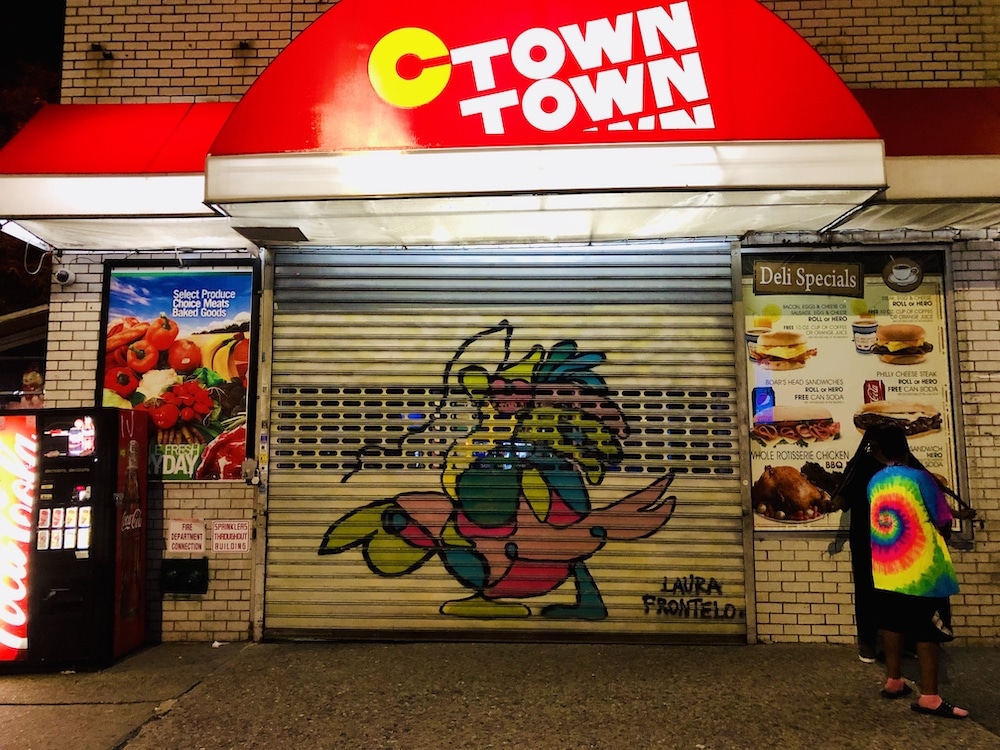
VIII
Avi Gitler’s partners were interested in creating a dialogue about climate justice, he told me in a larger conversation about the aims of the Audubon Mural Project, but that was not his goal. Personally, he wanted to put up great art, intending to reach kids. “My dream is that twenty-five years from now, an ornithologist will reach out to me to say they grew up in the neighborhood and were turned on to birds by the murals.”
Avi, a great-grandchild of Jewish refugees to Washington Heights from Europe, grew up in the neighborhood himself, in the 1990s when it was rough. His grandparents, born in the Heights, were kosher caterers. He attended the local Yeshiva University and its associated high school. With no formal background in the art world except for an education from the Met and the city’s other great art museums, he started an art business that led to the establishment of Gitler & ____ gallery on Broadway in 2014. It was the only commercial art business in the neighborhood. He felt jazzed about participating in revitalizing the neighborhood, attracting patrons who would shop in local stores and eat in local restaurants. He chose the location, in part, for its proximity to Audubon Terrace, where, he says, “you can see world-class art for free at the Hispanic Society Museum—probably the only place where you could steal a Velázquez if you spent an hour thinking about how you were going to do it.” He got permission from the neighboring store for an artist to paint a flamingo. Then a resident who worked at the Audubon Society noticed the bird, and told Avi about the climate report. Soon after, the mural project began.
The project has the approval of the community board and partnerships with local schools, such as the Washington Heights Expeditionary Learning School. (The fox sparrow was recently painted on an entrance to the school, in honor of its dedicated Environmental and Climate Science teacher, Dr. Jared Fox, who wants to develop a green corridor.) Several uptown artists were commissioned to contribute, including Yumi Rodriguez, and BlusterOne, who lives on 151st. BlusterOne painted the American redstart, for which they named a cocktail at the Harlem Public bar, and more recently, Three Little Birds, in honor of Bob Marley, which Avi described as “a positive message in an age of carnage.” Avi distinguished the project from the Wynwood Walls in Miami, a public mural project directed by a real estate entity to transform a blighted industrial warehouse district into what the Miami Herald described as a lucrative “red-hot residential zone with artistic soul.” In Avi’s view, the Audubon Mural Project is mindful of the history of street art, “trying to give voice to the voiceless. Who has more ultimate lack of agency than a population of birds?” He cited the AIDS era and work of Keith Haring as its origin, appearing “where nobody wanted to go.”
Now there are tours of the Harlem murals on Sunday mornings, offered through the New York City Audubon, for thirty dollars a head.
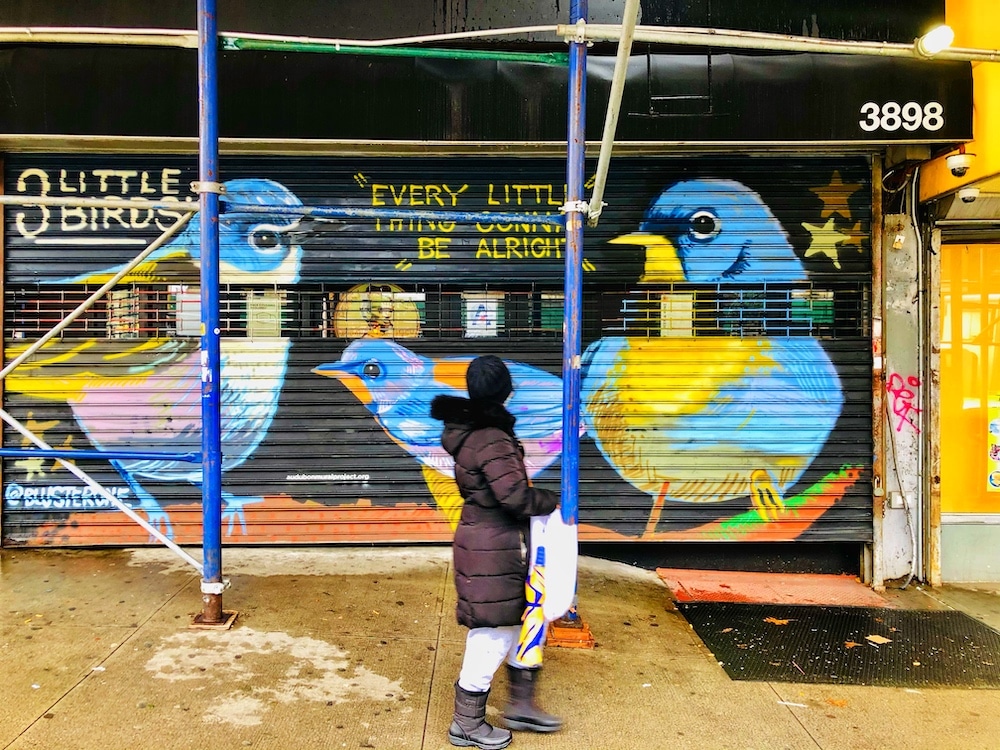
IX
I first met Karen Taylor years ago at an exhibit of the family photos of her husband, whose Harlem roots extend eight generations. Karen is founder and executive director of While We Are Still Here. According to its website, the nonprofit organization formed as “a response to the threat that each building’s history would be lost and gone forever, partially due to the passing of time, and partially due to ‘gentrification,’ which is rapidly altering the environment.” Before the wrecking ball of displacement demolishes community memory, Karen aims to codify it, while we are still here, so more people can learn how ordinary Black migrants, primarily from the South, sought refuge from domestic terror and wound up transforming Harlem into a global center of intellectual, artistic, and political influence.
While We Are Still Here is dedicated to the preservation of Harlem’s Black history, particularly as it played out in two historic buildings on Edgecombe Avenue, 409 (where Karen lives) and 555. Luminary residents of these addresses in the early and mid-twentieth century included W.E.B. DuBois, Walter White, James Weldon Johnson, Thurgood Marshall, Joe Louis, Paul Robeson, and Count Basie—though Karen is quick to point out that regular folks lived there too: beauticians, musicians, and gangsters alike. She believes their collective legacy of fighting inequality leaves a blueprint for our current struggles. I believe she is right.
“Many people seem to have no idea that this community was full of involved and evolved people who lived, worked, thrived, and engaged in activities such as seeing to it that their children were educated, curating art shows in church basements and storefronts or on the sidewalk, and coaching Little League teams, as well as offering instruction in the various art forms,” began Karen when I asked her how she felt about the birds. It struck me that she was speaking about our community in the past tense. Her impulse to preserve its history ran parallel to the mural project.
Unlike me, Karen wasn’t a fan of the bird project. Normally outspoken, she had difficulty articulating why she felt provoked by it. It wasn’t so much that its namesake was “a slave-owning white nationalist,” as she’d learned during her time working for Audubon magazine, but that this tribute to his legacy was unfolding now, when Black people in Harlem were being displaced. She allowed that the project might be fueled by someone else’s idea of beauty. To her, the birds’ faces were frightening. “They all look like raptors,” she said, referring to the same five-story mural by Lunar New Year that bugged out Kamila. Furthermore, Karen took umbrage with the proprietor of a new café called the Monkey Cup who said she liked the project because it offered kids something beautiful to look at—as though beauty was lacking before the birds showed up.
There’s nothing wrong with sounding the alarm that birds are suffering because of climate change, Karen concluded—but if she had the funding, she’d pay artists to commemorate the Lenape people of the region displaced by European expansionism, and the Black people who made Harlem.
X
Let us imagine the servant ordered down on all fours
In the manner of an ottoman whereupon the boss volume
Of John James Audubon’s “Birds of America” can be placed.
Terrance Hayes offers this image of casual violence in his poem, “Antebellum House Party.” An absurd degradation. The Black body as a prop. The problem with the picture is that it’s so easy for us to imagine. Easier than it is to imagine a sky without birds.
XI
On Amsterdam and 163rd Streets, ten blocks from Karen’s building is one of the Audubon Mural Project’s boldest works: Endangered Harlem. Painted by street artist Gaia, it takes up the entire facade of an apartment block. This mural includes four species of migratory songbirds: the black-and-white warbler, magnolia warbler, scarlet tanager, and tree swallow (passerines, all). In the top right corner Gaia painted a portrait of John James Audubon as a young man; in the bottom right, a photo by Russell Lee taken in the South Side of Chicago in 1941, during the swell of the Second Great Migration; in the bottom left, the hand of James Lancaster, who led the East India Company’s first fleet in 1600, resting on a globe.
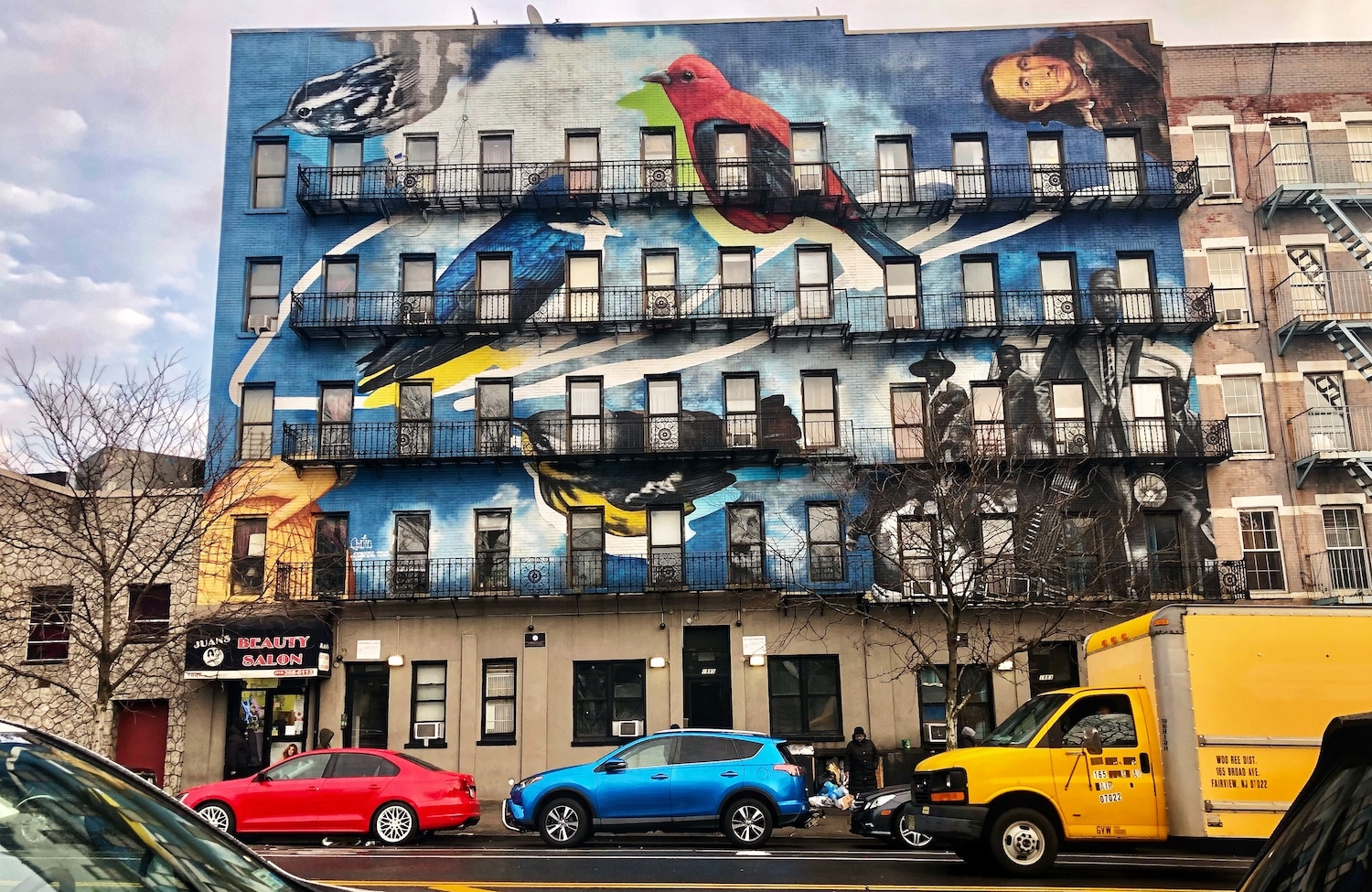
“I’m grateful to be able to be a part of the Audubon Mural Project and to have had the opportunity to push this photoshop method of arranging history visually,” Gaia shares on Audubon’s website. “These three patterns of migration run parallel to one another. But the greatest irony of it all is raising ecological awareness whilst the people of Harlem are endangered of significant gentrification.”
One doesn’t have to go to a national park or a far-flung part of the planet to see them. They are everywhere.
I felt that irony while shooting the great gray owl, by the artist Key Detail, one of my favorite bird murals. I wanted to document it before it was gone. I stood there a long time in front of the Daliza Pharmacy, trying to frame the shot to put a person on an equal plane. “You gonna buy this building?” a man confronted me. He was missing some teeth, looked in rough shape, maybe unsheltered. He’d known the owner, he said, back in the day. He felt bewildered by the changes, like at the Chipped Cup: a fishbowl full of white people, as he put it. “No,” I told him, “I just like the bird.” He considered the owl, and spat on the sidewalk. “Fucking birds,” he cursed.
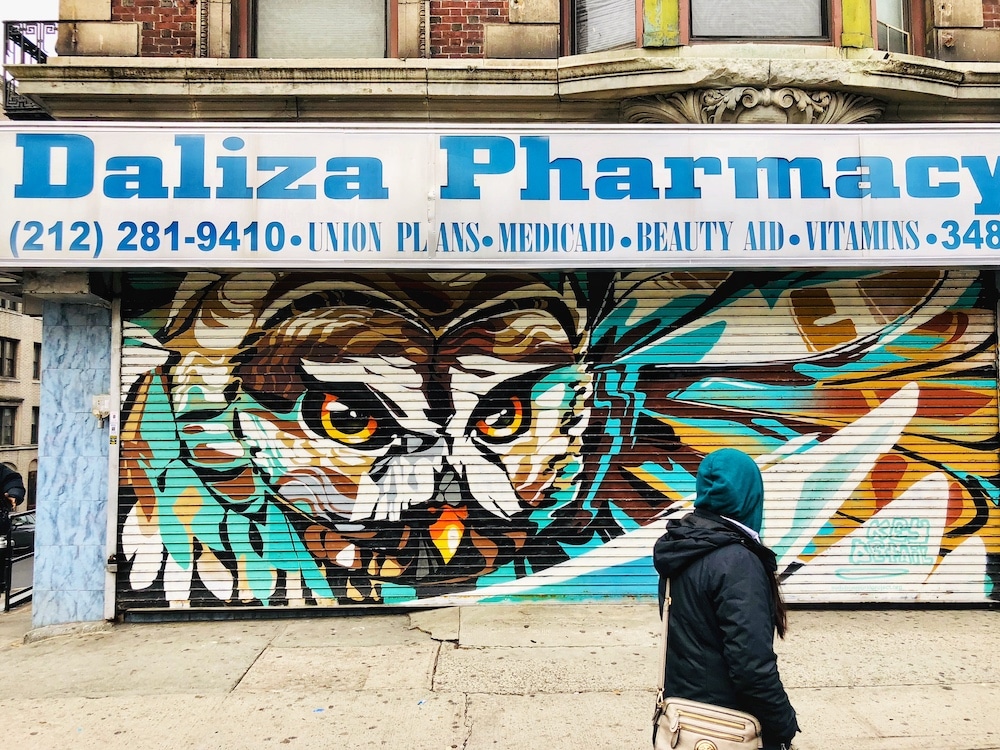
XII
Brooklyn-based studio artist George Boorujy, who painted Gang of Warblers on Dibond with outdoor house paints, wanted to depict them as a bunch of tough guys because they make massive migration journeys, some inconceivable for creatures so small. He also hung two other billboard-size warbler paintings over the subway entrance at 157th Street, a difficult installation performed on a lift in the middle of the night in winter, ripping down calcified signage for a drink called “Energy 69.” From that vantage he witnessed the Rockefeller Christmas tree being driven down Broadway.
When I asked why George was drawn to warblers, he said, “I feel as though warblers in particular can be important ambassadors for conversation, like a gateway drug.” He’s noticed it’s often the spring migration of warblers, especially in the eastern U.S., that gets people interested and then hooked on bird-watching. “This curiosity leads to learning about these birds, and the first step to caring about something is knowing about it. The fact that these birds live in multiple countries also encourages a broader view of conservation. If a birder in Ohio wants to see the return of ‘their’ warblers, they have to also be invested in preserving habitat in Central and South America and the Caribbean.”

There are 3 billion fewer birds in the U.S. and Canada than fifty years ago. That’s a staggering 29 percent. We know this because of the bird-watchers who, having caught the spark, and out of devotion, submit their observations to databases and help carry out population surveys year after year.
Conservationists say the birds are dying because of pesticides, habitat loss, urbanization, and development, as with glass-clad high-rise buildings like the Circa, on the corner of 110th and Central Park West, in front of which, especially during migration season, dozens of bird carcasses can be found each morning on the sidewalk after window strikes. Some researchers point to climate change. In fall 2020, scientists reported a mass die-off of up to a million migratory birds across the U.S. Southwest and Mexico, many with little muscle mass, seeming to have dropped dead from the sky mid-flight, like the proverbial canaries in a coal mine. The ongoing wildfires of the west were considered a factor. Of the disappearing birds, warblers are among the worst hit groups, and therefore, the most commonly represented in the murals. Their population has declined by 617 million in the last half century.
George feels the barrier of entry to bird-watching, and thus a connection to wildlife, is low. I’m not sure that’s the case, though I want it to be. In his view, one doesn’t have to go to a national park or a far-flung part of the planet to see them. They are everywhere. And one’s connection and concern for them leads one to care about environmental issues everywhere. “Our birds are their birds too. It’s all connected,” he says.
XIII
I reached the corner of 135th Street and Amsterdam to watch Marthalicia Matarrita, in her paint-splattered pants, finish making the gray hawk. It was November, the saddest month. Even from across the street, the mural’s lush green background suggested treetops. I saw the finely barred chest pattern, the rounded wings, the hooked beak, and the magnificent thing Marthalicia had done. She had taken the bird out of the sky to ground in our midst. And she had elevated us to its height. The hawk was about to land: talons reaching sharply for the perch, gaze intent, tail feathers spread for balance.
Marthalicia was slightly rattled. An old man she knew from the church she used to attend on 133rd had just confronted her, demanding to know: “Are you making this for us or for them?”
That was the wrong question. At the base of Marthalicia’s stepladder were $140 worth of spray paint cans. This was her second go at the hawk, which she chose, in part, because it reminded her of her mother’s gray hair. In her first version, the bird was already perched on the branch. But too much white space was left on the wall, and she worried it would get tagged over. So she redid it with its wings spread, working from a photograph.
Marthalicia grew up in the neighborhood in a string of apartments in what she describes as the “Harlem band,” stretching from the west side to the east. Sharp life turns moved her family from one place to the next. They were evicted from 137th and Riverside. For a time they lived on 145th. Her interest in art made her an outlier. “I’m not artistically supported by my family or my community,” she said. The sharp turns continued. She went to SUNY New Paltz to study art, having joined the Army Reserve to pay for school, but was yanked from her studies by a call to Kuwait and a pregnancy. Now, age forty-two, she lives with her two children in a basement apartment in the Bronx, without room to make work, except outside. It’s what she can afford.
Birds, in Marthalicia’s view, are spiritual messengers. She too noticed a pattern. Before a friend or family member would die, she’d see a dead pigeon. Or after someone passed, she’d see white feathers and wonder if it was a sign. “When you’re from the city, you look down. You don’t call attention to yourself, especially as a woman. You keep your guard up. Nobody looks at the sky.” But birds, she felt, were trying to tell her something.
Sometimes they’d land near her. Crows. Hawks. Gulls. Previously, all she’d been aware of were water bugs, roaches, rats, and pigeons. Remembering the big earthquake in Haiti in 2010, when animals were attuned to the vibrations of oncoming disaster before people, she asked, “and we’re supposed to be more advanced?
The artist shakes the can of white. Its bead rattles. She holds the printed picture of the gray hawk up against the wing she’s made on the wall, using the paper’s edge to make short straight white lines with the spray paint. The mural is beginning to look real. She lingers on the flight feathers. Then she stops. Looks up. Points out the hawk circling above the building at City College where I teach writing. Her face is picture of awe.
She tells me it’s the anniversary of her mother’s death. The hawk is doing what hawks do. Together, we watch her painting the sky. O
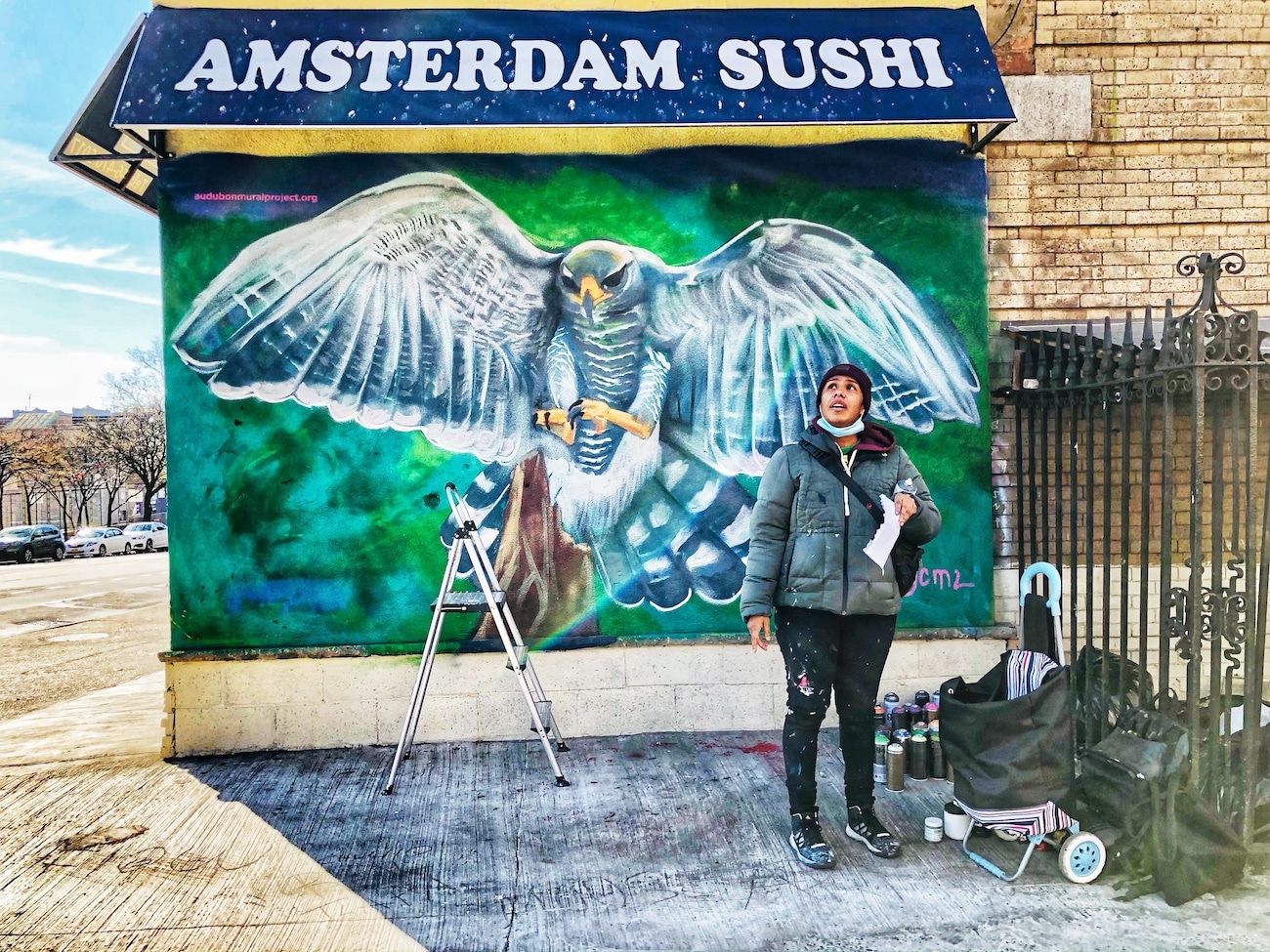



Comments
Thank you! What a beautiful, beautiful essay, which I come upon just as I happen to be reading The Professor’s Daughter–and, of course, thinking, as I have for the past twenty years, about birding and the end of nature and what that means for humans from different generations and different parts of the world. Emily, “Accidentals” is a novel about birds and humans that I hope will bring you as much comfort and discomfort as your writing is bringing me.
Kind thanks to Ms. Raboteau for all of this. For helping us to see.
An absolutely remarkable genre-bending piece—poetic, prophetic and breathtaking in its form.
Thank you dear Emily for this enriching and moving piece on birds and the exalted brushstrokes of their wingspans…What a poetic and beautiful way to put the incredible beauty of birds in words! Love and deep appreciation. Please keep writing for the wild and free, lovely and vanishing life forms all around us…
The integration of the loss of wild life and the losses faced by people of colour especially the poor is exceptionally well done. It is very enlightening for those of us whose life has been a steadier transition. We need more awareness and a better way to take better care of the birds and the people. Thank you so much.
Gorgeous writing and deeply thought provoking. We rarely see a whole picture, but focus instead on our own feelings in reaction. This article captures competing ways to view, and feel about a project. Very worth the time.
Thank you! This is extraordinary writing. I deeply appreciate the depth of conservation details and breath of vitally important social justice issues. The best article I have read in a long time. Thank you so very much.
What an incredible essay. Ripe with metaphors and deep meaning in an era where we are finally confronting our bigotry in a quest for racial and social justice. I love encountering these birds while running around the hood and will relish finding the deeper meaning they represent.
What a beautiful way to tie together climate change, gentrification, displacement, loss of habitat and
dwindling bird species. As well as the artistic desire to create and message. A very spiritual, will written
article.
Thank you,
Thank you for this. The birds are original inhabitants of the island too. They are indigenous and deserve space, acknowledgment, and protection as much as any human. We are all related.
Please Note: Before submitting, copy your comment to your clipboard, be sure every required field is filled out, and only then submit.